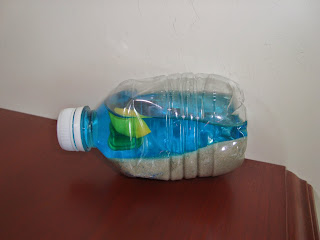
Sink and Float
You’ll need a file folder, tub of water, and a collection of small objects (pencil, crayon, paper clip, ball, block, pebble, leaf, etc.) On one side of the file folder write “float” and on the other side write “sink.” Children place the items according to whether they think they will float or sink. They can then test each object by putting it in the water and readjusting where it should go.
Beach Bottle
Put ½ cup sand in a bottle. Add some shells and fill half way with water. Add a drop of blue food coloring. Make a small fish from Styrofoam or a water balloon.

Wave Bottle
Fill 2/3 full with water. Add a drop of food coloring. Fill to the top with vegetable oil or Baby oil. Slowly rotate the bottle on its side to make waves.
*Add glitter if you like.
Fill 2/3 full with water. Add a drop of food coloring. Fill to the top with vegetable oil or Baby oil. Slowly rotate the bottle on its side to make waves.
*Add glitter if you like.

Sand Collections
Collect sand from various beaches in jars or bottles and label. Children can use a magnifying glass to observe the contents. How are they alike? How are they different?
*They could do descriptive writing about what they see in the bottle.
*A good way to get sand samples is to have children write friends and relatives who live near a lake or ocean and ask them to sand a small bag of sand to their class. (Be aware that there are some restrictions as to sending natural objects into the continental 48 states.)

Research
Purchase a bag of shells from a dollar store and put it out with a book about seashells. Children can look through the book and identify the shells.

